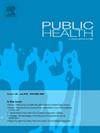Trends in the prevalence of cardiometabolic diseases in US adults with newly diagnosed and undiagnosed diabetes, 1988–2020
IF 3.9
3区 医学
Q1 PUBLIC, ENVIRONMENTAL & OCCUPATIONAL HEALTH
引用次数: 0
Abstract
Objectives
Early detection and timely management of cardiometabolic diseases (CMDs) in diabetes are critical for preventing vascular complications and premature mortality. However, the prevalence of CMDs over time in adults with newly diagnosed and undiagnosed diabetes is unclear.
Study design
Cross-sectional study.
Methods
Included were US adults aged ≥20 years with newly diagnosed diabetes and undiagnosed diabetes using data from the National Health and Nutrition Examination Survey in 1988–2020. CMDs included obesity, severe obesity, dyslipidemia, hypertension, metabolic dysfunction-associated fatty liver disease (MAFLD), chronic kidney disease (CKD), and cardiovascular disease (CVD). Poisson regressions were used to assess trends in the prevalence of CMDs and to compare the prevalence between newly diagnosed and undiagnosed diabetes.
Results
For both diabetes phenotypes in 1988–2020, the prevalence of obesity and severe obesity increased and CKD decreased (P < 0.05). The prevalence of dyslipidemia decreased and MAFLD increased in undiagnosed diabetes (P < 0.05). In 2011–2020, the prevalence of CMDs ranged from 14.3 % for CVD to 78.6 % for dyslipidemia. No significant difference in the prevalence of all CMDs between the 2 diabetes phenotypes was observed.
Conclusions
The prevalence of CMDs remained high in US adults with newly diagnosed and undiagnosed diabetes during the previous 3 decades, with no significant difference in the prevalence between the 2 diabetes phenotypes.
1988-2020年美国新诊断和未诊断糖尿病成人心脏代谢疾病流行趋势
目的:糖尿病患者心脏代谢疾病的早期发现和及时治疗对预防血管并发症和过早死亡至关重要。然而,在新诊断和未诊断糖尿病的成年人中,慢性糖尿病的患病率随时间的变化尚不清楚。研究设计:横断面研究。方法:纳入年龄≥20岁的新诊断糖尿病和未诊断糖尿病的美国成年人,使用1988-2020年国家健康与营养检查调查的数据。CMDs包括肥胖、严重肥胖、血脂异常、高血压、代谢功能障碍相关的脂肪性肝病(MAFLD)、慢性肾脏疾病(CKD)和心血管疾病(CVD)。泊松回归用于评估慢性糖尿病患病率的趋势,并比较新诊断和未诊断糖尿病的患病率。结果:对于1988-2020年两种糖尿病表型,肥胖和重度肥胖的患病率增加,CKD下降(P结论:在过去30年中,美国成人新诊断和未诊断糖尿病患者的CMDs患病率仍然很高,两种糖尿病表型之间的患病率无显著差异。
本文章由计算机程序翻译,如有差异,请以英文原文为准。
求助全文
约1分钟内获得全文
求助全文
来源期刊

Public Health
医学-公共卫生、环境卫生与职业卫生
CiteScore
7.60
自引率
0.00%
发文量
280
审稿时长
37 days
期刊介绍:
Public Health is an international, multidisciplinary peer-reviewed journal. It publishes original papers, reviews and short reports on all aspects of the science, philosophy, and practice of public health.
 求助内容:
求助内容: 应助结果提醒方式:
应助结果提醒方式:


